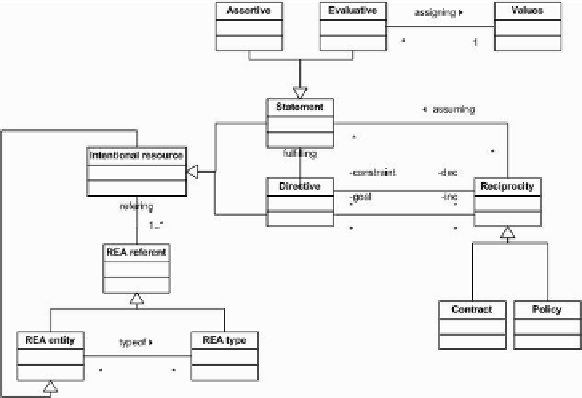Information Technology Reference
In-Depth Information
However, unlike types and
like assertives, they have a
We have extended REA al
in terms of good, bad, satis
are produced using other in
direction-of-fit, like the exp
groups, commitments do not correspond to an abstracti
a propositional structure with references to REA refere
so with a value dimension. Values qualify REA refere
sfactory, fast etc.
Evaluations
are intentional resources t
ntentional resources and assign values; they do not hav
pressive in [18].
ion;
ents.
ents,
that
ve a
Fig. 2.
.
REA management ontology (UML style)
As any resources, intenti
tional events
. For instance
decommit events [24]. Inte
nicative acts to be represent
In REA, commitments a
procal commitments (what
may contain additional term
concepts as well. According
principles and associated g
of an organization, to direc
have formalized them in an
ing the reciprocity principle
Constraints
are what the a
trolled system) and
goals
a
fulfilled by monitored asse
assumptions
in the form of
The definition of policy
which defines a policy enti
exchanges and conversions
are part of the policy, but
“apply” relationship is a spe
ional resources are processed by events that we call
int
e, commitments are created or removed by commit
entional events are typically realized by means of comm
ted on the process level.
are grouped together in contracts. A
contract
contains re
t the agent will give versus what he aims to receive)
ms. From a management perspective,
policies
are import
g to the BusinessDictionary.com, a policy is “
a set of ba
guidelines, formulated and enforced by the governing b
ct and limit its actions in pursuit of long-term goals
”.
alogy to contracts as a group of intentional resources ob
e: what the agent gives in versus what he aims to achie
gent gives in (directives that limit the actions of the c
are what the agent wants to gain in return (directives to
ertives or evaluations). In addition, the policy may cont
testable assertives.
can be seen as a generalization of the policy pattern in
ity as something that encapsulates constraints on econom
and that “applies” to a group. In our definition, constra
t always linked via the policy to goals. In our view,
ecial kind of “referring”.
ten-
and
mu-
eci-
and
tant
asic
body
We
bey-
eve.
con-
o be
tain
[6],
mic
aints
the

